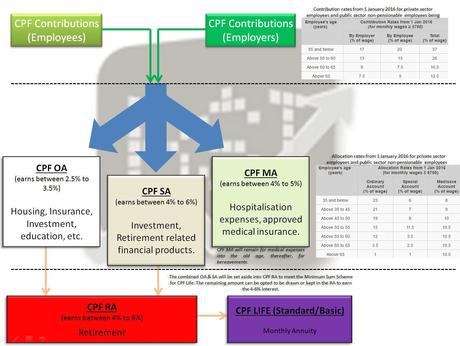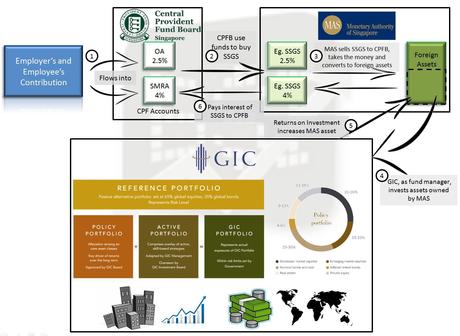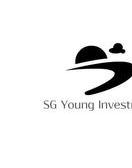
Source: CPF's website
- Written By Byte Sized Investment
Central Provident Fund, CPF in short, is a compulsory savings plan for working Singaporeans and Permanent Residents (PR), primarily to fund their retirement. It could also be used for healthcare, education, and housing needs. Both employers and employees contribute a mandated amount to the employee's CPF retirement fund, where it grows and earns interest between 2.5% to 5%.
#For CPF members above age 55, they can earn up to 6% per annum on their retirement balances! You can find out more on the interest rates here.
The 4 CPF accounts are as follows:
1.Ordinary Account (OA) - for housing, pay for CPF insurance, investment and education.
2.Special Account (SA) - for old age and investment in retirement-related financial products. Interest for CPF SA 4-5% per annum.
3.Medisave Account (MA) - for hospitalisation and approved medical insurance.
4.Retirement Account (RA) - created when one turns 55 using the savings in OA and SA. It is set up to meet basic needs during old age.
#The Special, Medisave and Retirement Account are simplified to be known as SMRA.

What does the government do with the money?
CPF monies are invested in Special Singapore Government Securities (SSGS) that are issued and guaranteed by the Singapore Government through Monetary Authority of Singapore (MAS). The proceeds from the SSGS, owned by MAS, are then managed by the fund manager: Government of Singapore Investment Corporation, more commonly known as GIC. GIC invest the proceeds on behalf of MAS. With the returns from investment, MAS pays the interest on the SSGS to CPF board.

One can reduce up to $14,000 of his taxable income if he were to do a $7,000 cash top up into his CPF SA and another $7,000 combined to his loved ones' CPF SA (parents and spouse). This means it reduces his taxable income by $14,000. Let's put some context to these numbers.
According to data provided by Ministry of Manpower (MOM), the median gross monthly income is at S$3,949, and including 13th month bonus, this translates to S$51,337 annually. This is the amount that our example 28-years old Joe is earning a year in the private sector.
Joe would receive a total of $1,000 and $10,258 of tax relief from earned income* and CPF contributions** (to know more about how to reduce your tax, visit IRAS deductions for individuals here, click here to calculate CPF Contributions). His taxable income would be $40,079, and he would pay taxes of $555.53 for the assessment year of 2017.
However, should Joe choose to transfer $7,000 cash into his CPF SA, he will reduce his taxable income by $7,000, to $33,079 instead of $40,079. Joe would then instead pay $307.77 in taxes. This is a 65% decrease in taxes paid.
If Joe does another cash transfer of $7,000 to his wife and/or parents, he will further reduce the chargeable income by another $7,000, to $26,079. He will pay $121.58 in tax. That's a 78% tax savings!
Of course, for someone who earns the median income of $51,000 a year, to have up to $7,000 transferred into CPF SA would leave Joe cash-poor as he has to juggle the remaining $34,079 (~$2,800/month), net of CPF contributions, to settle housing and car loans, insurance, food, utility, entertainment, living expenses etc. The $7,000 top up into CPF SA can only be drawn after age 55. For a breadwinner like Joe, cashflow might be a challenge. The savings on tax might not outweigh the need for cash, especially during emergencies.
Let's explore the effects on Jack, similarly 28 years of age, who earns an average income of $6,000 a month. Working in the private sector, let's assume Jack's annual salary package including the 13th month would be $78,000.
Jack would receive a total reduction of $1,000 and $15,600 from his taxable income due to earned income and CPF contributions. His taxable income would be $61,400, and he would pay taxes of $2,048 for the assessment year of 2017. But Jack being financially savvier, planned his cashflow and finances well, and he can afford to transfer $7,000 cash into his CPF SA, lowering his chargeable income to $54,400 instead. Thus Jack pays $1,558 in taxes, a saving of almost $500 or 24% in tax!
Comparing the opportunity costs
Putting $7,000 into his CPF SA would leave him with around $62,400 annually ($5,200/month) after deduction from the CPF contributions for his living expenses. If Jack's annual expenses are below $62,400, whatever income left sits in the bank earning a measly 0.05% interest. At the same time, Jack has to pay the additional $500 in tax. On the flip side, if he does this CPF cash top up, he would not only save $500, his cash top up in CPF would earn him an additional 4% interest, or $280 the next year. That is a $780 opportunity cost, 11% of $7,000!
Hence, if the $7,000 cash top up does not put too much strain on Jack's cashflow and finances, doing this top up seems worthwhile.
This tax savings is significant.
At age 28, Jack will continue to work at least another 34 years till he reaches the official retirement age at 62. Assume his pay stays stagnant, the tax savings of $500 a year would result in $17,000 after 34 years!
As our tax is progressive, where the low income earners pay as little as 2% to no tax and the high income earners pay up to 22% to the government in tax, a person who climbs the corporate ladder would have increasing income, thereby incurring a higher proportion of tax compared to when he was much younger. In some cases, I estimated that the tax savings could be up to $21,000 in 34 years.
Anyway, this notion isn't new, a famous blogger (AK71), who earns more than $165,000 from dividends a year, had been advocating it a long time.
Well, if you think a 24% or a $17,000 tax savings is little, wait till you see how much returns you could gain over the years with the additional $7,000 cash contributions you made.
*Deduction from Earned Income. Earned Income refers to the taxable earned income from employment, pension, trade, business, profession or vocation less allowable expenses. The amount of relief is based on your age and taxable earned income in the assessment year. For non-handicapped employees below age 55, the deduction of taxable income is up to $1,000. For more information, click here.
**Deduction from CPF Contribution. Your portion (not the employer's) of mandatory CPF contributions counts towards a reduction in taxable income.For every $1 you contribute to CPF, your taxable income is reduced by $1. For more information on the CPF contribution relief click here. To calculate how much CPF you will be contributing, click here.

